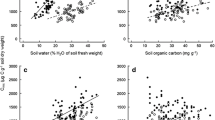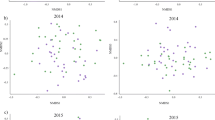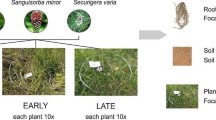Abstract
Does plant diversity drive soil microbial diversity in temperate, upland grasslands? Plants influence microbial activity around their roots by release of carbon and pot studies have shown an impact of different grass species on soil microbial community structure. Therefore it is tempting to answer yes. However, evidence from field studies is more complex. This evidence is reviewed at three different scales. First, studies from the plant community scale are considered that have compared soil microbial community structure in pastures of different vegetation composition, as a consequence of pasture improvement. These show fungi dominating the biomass in unimproved pastures and bacteria when lime and fertilizers have been applied. Secondly, evidence for interactions between individual grass species and soil microbes is discussed at the level of the rhizosphere, by considering both pot experiments and field studies. These have produced contrasting and inconclusive results, often due to spatial heterogeneity of soil properties and microbial communities. In particular, increased soil pH and fertility in urine patches and other nutrient cycling processes interact to increase the spatially complexity of soil microbial communities. Finally three studies which have measured microbial community structure in the rhizoplane are considered. These show that bacterial diversity is not directly related to plant diversity, although fungal diversity is. In addition, the soil fungal community has been demonstrated to have an effect upon the composition of the bacterial community. We suggest that while current vegetation influences fungal communities (particularly mycorrhizae) and litter inputs fungal saprotrophs, bacterial community structure is influenced more by the quality or composition of soil organic matter, thereby reflecting carbon inputs to the soil over decades.


Similar content being viewed by others
References
Artursson V, Findlay RD, Jansson JK (2005) Combined bromodeoxyuridine immunocapture and terminal-restriction fragment length polymorphism analysis highlights differences in the active soil bacterial metagenome due to Glomus mosseae inoculation or plant species. Environ Microbiol 7:1952–1966
Badri DV, Vivanco JM (2009) Regulation and function of root exudates. Plant Cell Environ 32:666–681
Bahn M, Schmitt M, Siegwolf R, Richter A, Brüggermann N (2009) Does photosynthesis affect grassland soil-respired CO2 and its carbon isotope composition on a diurnal timescale? New Phytol 182:451–460
Bardgett RD, Hobbs PJ, Frostegård A (1996) Changes in soil fungal:bacterial biomass ratios following reductions in the intensity of management of an upland grassland. Biol Fert Soils 22:261–264
Bardgett RD, Leemans DK, Cook R, Hobbs PJ (1997) Seasonality of soil biota of grazed and ungrazed hill grasslands. Soil Biol Biochem 29:1285–1294
Bardgett RD, Wardle DA, Yeates GW (1998) Linking above-ground and below-ground food webs: how plant reponses to foliar herbivory influence soil organisms. Soil Biol Biochem 30:1067–1078
Bardgett RD, Mawsdsley JL, Edwards S, Hobbs PJ, Rodwell JS, Davies WJ (1999) Plant species and nitrogen effects on soil biological properties of temperate upland grasslands. Funct Ecol 13:650–660
Berg G, Smalla K (2009) Plant species and soil type cooperatively shape the structure and function of microbial communities in the rhizosphere. FEMS Microbiol Ecol 68:1–13
Bezemer MT, Lawson CS, Hedlund K, Edwards AR, Brook AJ, Igual JM, Mortimer SR, Van der Putten WH (2006) Plant species and functional group effects on abiotic and microbial soil properties and plant–soil feedback responses in two grasslands. J Ecol 94:839–904
Brodie E, Edwards S, Clipson N (2002) Bacterial community dynamics across a floristic gradient in a temperate upland grassland ecosystem. Microb Ecol 44:260–270
Buckley DH, Schmidt TM (2003) Diversity and dynamics of microbial communities in soils from agro-ecosystems. Environ Microbiol 5:441–452
Buyer JS, Roberts DP, Russek-Cohen E (2002) Soil and plant effects on microbial community structure. Can J Microbiol 48:955–964
Chabrerie O, Laval K, Puget P, Desaire S, Alard D (2003) Relationship between plant and soil microbial communities along a successional gradient in a chalk grassland in north-western France. Appl Soil Ecol 24:43–56
Chung H, Zak DR, Reich PB, Ellsworth DS (2007) Plant species richness, elevated CO2, and atmospheric nitrogen deposition alter soil microbial community composition and function. Global Change Biol 13:980–989
Clegg CD, Ritz K, Griffiths BS (2000) %G+C profiling and cross hybridization of microbial DNA reveals great variation in below-ground community structure in UK upland grasslands. Appl Soil Ecol 14:125–134
Girvan MS, Bullimore J, Pretty JN, Osborn AM, Ball AS (2003) Soil type is the primary determinant of the composition of the total and active bacterial communities in arable soils. Appl Environ Microbiol 69:1800–1809
Grayston SJ, Wang S, Campbell CD, Edwards AC (1998) Selective influence of plant species on microbial diversity in the rhizosphere. Soil Biol Biochem 30:369–378
Grayston SJ, Griffith GS, Mawdsley JL, Campbell CD, Bardgett RD (2001) Accounting for variability in soil microbial communities of temperate upland grassland ecosystems. Soil Biol Biochem 33:533–551
Grayston SJ, Campbell CD, Bardgett RD, Mawdsley JL, Clegg CD, Ritz K, Griffiths BS, Rodwell JS, Edwards SJ, Davies WJ, Elston DJ, Millard P (2004) Assessing shifts in microbial community structure across a range of grasslands of differing management intensity using CLPP, PLFA and community DNA techniques. Appl Soil Ecol 25:63–84
Griffiths RI, Bailey MJ, McNamara NP, Whiteley AS (2006) The functions and components of the sourhope soil microbiota. Appl Soil Ecol 33:114–126
Haichar FE, Marol C, Berge O, Rangel-Castro JI, Prosser JI, Balesdent J, Heulin T, Achouak W (2008) Plant host habitat and root exudates shape soil bacterial community structure. ISME J 2:1221–1230
Hamilton EW, Frank DA, Hinchey PM, Murray TR (2008) Defoliation induces root exudation and triggers positive rhizospheric feedbacks in a temperate grassland. Soil Biol Biochem 40:2865–2873
Haynes RJ, Williams PH (1993) Nurient cycling and soil fertility in the grazed pasture ecosystem. Advan Agron 49:119–199
Hedlund K, Santa Regina I, Van der Putten WH, Lepš J, Díaz T, Korthals GW, Lavorel S, Brown VK, Gormsen D, Mortimer SR, Rodríguez Barrueco C, Roy J, Smilauer P, Smilauerová M, Van Dijk C (2003) Plant species diversity, plant biomass and responses of the soil community on abandoned land across Europe: idiosyncracy or above-belowground time lags. Oikos 103:45–58
Hoult EH, McGarity JW (1986) The measurement and distribution of urease activity in a pasture system. Plant Soil 93:359–366
Innes L, Hobbs PJ, Bardgett RD (2004) The impact of individual plant species on rhizosphere microbial communities in soils of different fertility. Biol Fert Soils 40:7–13
Kaštovská E, Šantrůčková H (2007) Fate and dynamics of recently fixed C in pasture plant-soil system under field conditions. Plant Soil 300:61–69
Klironomos JN, Rillig MC, Allen MF (1999) Designing below ground field experiments with the help of semi-variance and power analysis. Appl Soil Ecol 12:227–238
Kowalchuk GA, Buma DS, de Boer W, Klinkhamer PGL, Van Veen JA (2002) Effects of above ground plant species composition and diversity on the diversity of soil-borne microorganisms. Antonie Van Leeuwenhoek 81:509–520
Kuzyakov Y, Friedel JK, Stahr K (2000) Review of mechanisms and quantification of priming effects. Soil Biol Biochem 38:3267–3278
Leake JR, Ostle NJ, Rangel-Castro J, Johnson D (2006) Carbon fluxes from plants through soil organisms determined by field 13CO2 pulse-labelling in an upland grassland. Appl Soil Ecol 33:152–175
Maharning AR, Mills AAS, Adl SM (2009) Soil community changed during secondary succession to naturalised grasslands. Appl Soil Ecol 41:137–141
Maherali H, Klironomonas JN (2007) Influence of phylogeny on fungal communities assembly and ecosystem functioning. Science 316:1746–1748
Mahmood S, Prosser JI (2006) The influence of synthetic sheep urine on ammonia oxidizing bacterial communities in grassland soil. Fems Microbiol Ecol 56:444–454
Marilley L, Vogt G, Blanc M, Aragno M (1998) Bacterial diversity in the bulk soil and rhizosphere fractions of Lolium perenne and Trifolium repens as revealed by PCR restiction analysis of 16s rDNA. Plant Soil 198:219–224
Marriott CA, Hudson G, Hamilton D, Neilson R, Boag B, Handley L, Whishart J, Scrimgeour CM, Robinson D (1997) Spatial variability of soil total C and N and their stable isotopes in an upland Scottish grassland. Plant Soil 196:151–162
McCaig AE, Glover LA, Prosser JI (2001) Numerical analysis of grassland bacterial community structure under different land management regimens by using 16S ribosomal DNA sequence data and denaturing gradient gel electrophoresis banding patterns. Appl Environ Microbiol 67:4554–4559
McCulley RL, Burke LC (2004) Microbial community composition across the Great Plains: landscape versus regional variability. Soil Sci Soc Am J 68:106–115
Millard P, Singh BK (2005) Plant–soil interactions. In: Milne J (ed) Pastoral systems in marginal environments. Wageningen Academic Publishers, The Netherlands, pp 29–38
Nicol GW, Webster G, Glover LA, Prosser JI (2004) Differential response of archaeal and bacterial communities to nitrogen inputs and pH changes in upland pasture rhizosphere soil. Environ Microbiol 6:861–867
Nunan N, Wu K, Young IM, Crawford JW, Ritz K (2002) In situ spatial patterns of soil bacterial populations, mapped at multiple scales, in an arable soil. Microb Ecol 44:296–305
Nunan N, Daniell TJ, Singh BK, Papert A, McNicol J, Prosser JI (2005) Links between plant and rhizoplane bacterial communities in grassland soils, characterized using molecular techniques. Appl Environ Microbiol 71:6784–6792
Nunan N, Singh B, Reid E, Ord B, Papert A, Squires J, Prosser JI, Wheatley RE, McNicol J, Millard P (2006) Seep-urine-induced changes in soil microbial community structure. FEMS Mirco Ecol 56:310–320
Paterson E, Gebbing T, Abel C, Sim A, Telfer G (2007) Rhizodeposition shapes rhizosphere microbial community structure in organic soil. New Phytol 173:600–610
Paterson E, Osler G, Dawson LA, Gebbing T, Sim A, Ord B (2008a) Labile and recalcitrant plant fractions are utilised by distinct microbial communities in soil: independent of the presence of roots and mycorrhizal fungi. Soil Biol Biochem 40:1103–1113
Paterson E, Thornton B, Midwood AJ, Osborne SM, Sim A, Millard P (2008b) Atmospheric CO2 enrichment and nutrient additions to planted soil increase mineralization of soil organic matter, but does not alter microbial utilisation of plant- and soil C-sources. Soil Biol Biochem 40:2434–2440
Ridgeway KP, Duck MJ, Young PW (2003) Identification of roots from grass swards using PCR–RFLP and FFLP of the plastid trnL (UAA) intron. BMC Ecol 3:8
Ritz K, McNicol W, Nunan N, Grayston S, Millard P, Atkinson D, Gollottee A, Habeshaw D, Boag B, Clegg CD, Griffiths BS, Wheatley RE, Glover LA, McCaig AE, Prosser JI (2004) Spatial structure in soil chemical and microbiological properties in an upland grassland. FEMS Microbiol Ecol 49:191–205
Rodwell JS (1991) British plant communities, vol 1–4. Cambridge University Press, Cambridge
Rooney D, Kennedy N, Deering L, Gleeson D, Clipson N (2006) Effect of sheep urine deposition on the bacterial community structure in an acidic upland grassland soil. Appl Environ Microbiol 72:7231–7237
Rout ME, Chrzanowski TH (2009) The invasive Sorghum halepense harbors endophytic N2-fixing bacteria and alters soils biogeochemistry. Plant Soil 315:163–172
Saetre P, Bååth E (2000) Spatial variation and patterns in soil microbial community structure in a mixed spruce-birch stand. Soil Biol Biochem 32:909–917
Scheublin TR, Ridgway KP, Young JPW, Van der Heijden MGA (2004) Nonlegume, legume and root nodules harbour different arbuscular mycorrhizal fungal communities. Appl Environ Microbiol 70:6240–6246
Schmalenberger A, Hodge H, Bryant A, Hawkesford MJ, Singh BK, Kertesz MA (2008) The role of Variovorax and other Comamonadaceae in sulphur transformation by microbial wheat rhizosphere communities exposed to different sulfur fertilisation regimes. Environ Microbiol 10:1486–1500
Shand CA, Williams BL, Smith S, Young ME (2000) Temporal changes in C, P and N concentrations in soil solution following application of synthetic sheep urine to a soil under grass. Plant Soil 222:1–13
Shand CA, Williams BL, Dawson LA, Smith S, Young ME (2002) Sheep urine affects soil solution nutrient composition and roots: differences between field and sward box soils and the effects of synthetic and natural sheep urine. Soil Biol Biochem 34:163–171
Singh BK, Munro S, Reid E, Ord B, Potts JM, Paterson E, Millard P (2006) Investigating microbial community structure in soils by physiological, biochemical and molecular fingerprinting methods. Eur J Soil Sci 57:72–82
Singh BK, Munro S, Potts JM, Millard P (2007) Influence of grass species and soil type on rhizosphere microbial community structure in grassland soils. Appl Soil Ecol 36:147–155
Singh BK, Nunan N, Ridgway KP, McNicol J, Young PW, Daniell TJ, Prosser JI, Millard P (2008) The relationships between assemblages of mycorrhizal fungi and bacteria on grass roots. Environ Microbiol 10:534–541
Singh BK, Dawson LA, Macdonald CA, Buckland SM (2009a) Impact of biotic and abiotic interaction on soil microbial communities and functions: a field study. Appl Soil Ecol 41:239–248
Singh BK, Nunan N, Millard P (2009b) Response of fungal, bacterial and ureolytic communities to sheep urine deposition in a grassland soil. FEMS Microbiol Biol (in press)
Smalla K, Wieland G, Buchner A, Zock A, Parzy J, Kaiser S, Roskot N, Heuer H, Berg G (2001) Bulk and rhizosphere soil bacterial communities studied by denaturing gradient gel electrophoresis: plant-dependent enrichment and seasonal shifts revealed. Appl Environ Microbiol 67:4742–4751
Staddon PL, Ramsey CB, Ostle N, Ineson P, Fitter AH (2003) Rapid turnover of hyphae of mycorrhizal fungi determined by AMS microanalysis of 14C. Science 300:1138–1140
Talbot JM, Allison SD, Treseder KK (2008) Decomposers in disguise: mycorrhizal fungi as regulators of soil C dynamics in ecosystems under global change. Funct Ecol 22:955–963
Usher MB, Sier ARJ, Hornung M, Millard P (2006) Understanding biological diversity in soil: the UK’s soil biodiversity research programme. Appl Soil Ecol 33:101–113
Van der Heijden MGA, Klironomos JN, Ursic M, Moutoglis P, Streitwolf-Ehgel R, Boller T, Wiemken A, Sanders IR (1998) Mycorrhizal fungal diversity determines plant biodiversity, ecosystem variability and productivity. Nature 396:72–75
Van der Heijden MGA, Bardgett RD, Van Straalen NM (2008) The unseen majority: soil microbes as drivers of plant diversity and productivity in terrestrial ecosystems. Ecol Letts 11:296–310
Vogel TM, Pascal S, Jansson JK, Hirsch PR, Tiedje JM, van Elsas JD, Bailey MJ, Nalin R, Philippot L (2009) TeraGenome: a consortium for the sequencing of a soil metagenome. Nature Rev Microbiol 7:252
Whitehead DC (1995) Grassland Nitrogen. CAB International, Wallingford, UK 397 pp
Williams BL, Shand CA, Sellers S, Young ME (1999) Impact of synthetic sheep urine on N and P in two pastures in the Scottish uplands. Plant Soil 214:93–103
Williams BL, Grayston SJ, Reid EJ (2000) Influence of synthetic sheep urine on the microbial biomass, activity and community structure in two pastures in the Scottish uplands. Plant Soil 225:175–185
Zak D, Holmes WE, White DC, Peacock AD, Tilman D (2003) Plant diversity, soil microbial communities, and ecosystem function: are there any links? Ecology 84:2042–2050
Acknowledgments
This work was funded by the Scottish Governments’ Rural and Environment Research and Analysis Directorate. This paper is dedicated to Gilles Lemaire on the occasion of his retirement.
Author information
Authors and Affiliations
Corresponding author
Rights and permissions
About this article
Cite this article
Millard, P., Singh, B.K. Does grassland vegetation drive soil microbial diversity?. Nutr Cycl Agroecosyst 88, 147–158 (2010). https://doi.org/10.1007/s10705-009-9314-3
Received:
Accepted:
Published:
Issue Date:
DOI: https://doi.org/10.1007/s10705-009-9314-3




